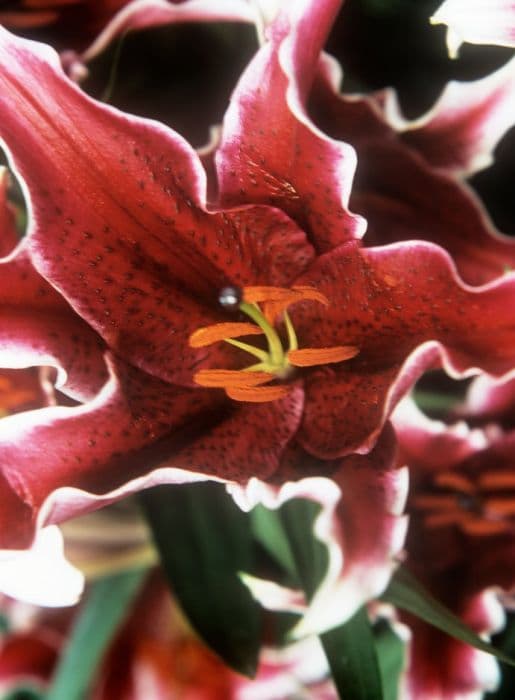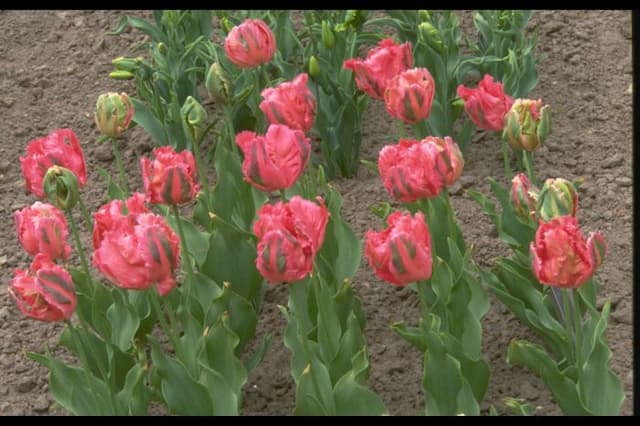Lily African Queen Group Lilium African Queen Group (Vi-/a)

ABOUT
African Queen Group are erect bulbous perennials with narrow leaves and large, fragrant apricot-orange trumpet-shaped flowers, tinged purple outside, in late summer
About this plant
 Names
NamesFamily
Liliaceae
Synonyms
African Queen Lily
Common names
Lilium African Queen Group.
 Characteristics
CharacteristicsLife cycle
Perennials
Foliage type
Deciduous
Color of leaves
Green
Flower color
Orange
Height
4 feet (1.2 meters)
Spread
1 foot (0.3 meters)
Plant type
Bulb
Hardiness zones
4
Native area
Africa
Benefits
 General Benefits
General Benefits- Aesthetic Appeal: The Lily (Lilium African Queen Group) offers large, trumpet-shaped flowers that provide a striking display of color in gardens or as cut flowers in arrangements.
- Pollinator Attraction: Its vibrant flowers attract bees, butterflies, and other beneficial pollinators to the garden, enhancing pollination of surrounding plants.
- Fragrance: The Lily emits a delightful fragrance that can add a pleasant scent to outdoor spaces and indoor environments when used as a cut flower.
- Versatility in Landscaping: This plant can be used in borders, beds, and containers, making it versatile for different garden designs and styles.
- Seasonal Interest: It blooms in the summer, offering garden interest during a season when many other plants may not be in flower.
- Easy to Grow: The Lily is known for being easy to cultivate, requiring minimal maintenance once established in suitable conditions.
 Medical Properties
Medical PropertiesThis plant is not used for medical purposes.
 Air-purifying Qualities
Air-purifying QualitiesThis plant is not specifically known for air purifying qualities.
 Other Uses
Other Uses- Culinary Garnish: The vibrant petals of the African Queen can be used to add a splash of color and elegance to gourmet dishes, especially in high-end restaurants.
- Textile Dye: The petals and stamens can provide natural dyes for fabrics, offering hues of orange and yellow.
- Perfumery: Essential oils extracted from the flowers can be used in creating fragrances with a sweet and floral notes.
- Insect Repellent: Certain compounds in the plant may be effective in repelling insects when applied to the skin or used in outdoor sprays.
- Photography Subject: Its striking appearance makes the African Queen a popular subject for botanical photographers and artists.
- Crafts: The flowers and dried stems can be incorporated into creative crafts, such as pressed flower art or natural potpourri mixes.
- Floral Arrangements: The long stems and large blooms make them ideal for tall vases and wedding bouquets.
- Education and Research: The plant can be used for educational purposes, such as teaching botany and genetics due to its distinct characteristics.
- Fish Poison: In some traditional practices, extracts from the plant were used to stun fish, making them easier to catch.
- Composting: After the blooms have faded, the biomass of the African Queen can be added to compost to enrich soil with organic matter.
Interesting Facts
 Feng Shui
Feng ShuiThe African Queen Lily is not used in Feng Shui practice.
 Zodiac Sign Compitability
Zodiac Sign CompitabilityThe African Queen Lily is not used in astrology practice.
 Plant Symbolism
Plant Symbolism- Royalty and Majesty: The African Queen Lily, with its regal poise and richly colored blooms, naturally evokes a sense of royalty and majesty reminiscent of the sovereign beauty one would associate with a queen.
- Wealth and Prosperity: Often plants that are deemed to be exotic or particularly striking, like the African Queen Lily, come to symbolize wealth and prosperity due to their lavish and rare beauty.
- Passion: The intense, vibrant hue of the African Queen Lily's flowers can suggest deep passion and a strong sense of love and affection.
- Rare Beauty: This variety of lily, being less common than others, can be used to represent unique or rare beauty, embodying the value of uniqueness.
- Renewal and Motherhood: As lilies in general are often associated with fertility and rebirth, the African Queen Lily too shares this symbolism, representing motherhood and the cycle of renewal.
 Water
WaterThe African Queen Lily should be watered thoroughly, ensuring the soil is evenly moist but not waterlogged. Water the plant when the top inch of the soil feels dry to the touch, which typically means once a week, but this can vary depending on environmental conditions such as temperature and humidity. Providing about a gallon of water per plant should suffice. During the active growing season in spring and summer, the lily may require more frequent watering. Reduce watering in the fall and further in winter when the plant is dormant.
 Light
LightThe African Queen Lily thrives best in full sunlight to partial shade. It should be placed in a spot that receives at least six hours of direct sunlight daily. However, in regions with hot afternoons, providing some afternoon shade can protect the blooms from intense heat. An east-facing garden that gets morning sun is ideal for these lilies.
 Temperature
TemperatureThe African Queen Lily prefers temperate conditions and is hardy in climates where the temperature typically stays between 40 to 85 degrees Fahrenheit. It can survive minimum temperatures down to about 20 degrees Fahrenheit, but for optimal growth, maintaining an environment where it does not regularly drop below freezing is ideal. It's important to protect the lily from extreme cold and heat.
 Pruning
PruningThe African Queen Lily should be pruned to remove spent flowers and dead or damaged foliage, which encourages new growth and maintains the plant’s appearance. Pruning is typically done after flowering, usually in late summer or early fall. Deadheading, or removing the flower heads after blooming, helps prevent the plant from expending energy on seed production.
 Cleaning
CleaningAs needed
 Soil
SoilAfrican Queen Lilies thrive in well-draining, fertile soil with plenty of organic matter. A mix of two parts loam, one part peat moss, and one part perlite or sand is ideal. These lilies prefer a slightly acidic to neutral soil pH, ranging from 6.0 to 7.0.
 Repotting
RepottingAfrican Queen Lilies typically do not need frequent repotting; do so every 3 to 4 years or when the bulbs outgrow their container. Best to repot them after the blooming season.
 Humidity & Misting
Humidity & MistingAfrican Queen Lilies prefer moderate humidity levels around 40-60%. They do not require excessively high humidity and can tolerate average indoor conditions.
 Suitable locations
Suitable locationsIndoor
Provide bright, indirect light and good air circulation.
Outdoor
Plant in well-draining soil in a sunny spot.
Hardiness zone
4-9 USDA
 Life cycle
Life cycleThe life of the African Queen Lily typically begins with the planting of a bulb in autumn or spring, which then produces roots and a shoot. The shoot grows into a stem, which gives rise to leaves as it elongates, ultimately producing a tall, robust plant. In summer, the African Queen Lily blooms, displaying trumpet-shaped flowers that are orange with maroon streaks, emitting a strong fragrance. After flowering, the plant sets seeds in pod-like structures if pollination occurs, although many gardeners remove the flowers to encourage the bulbs to store more energy. The leaves and stem wither and die back as the plant goes dormant in the fall, with the bulb surviving underground through winter. The next growing cycle begins the following spring when the bulb sends up new shoots, repeating the process.
 Propogation
PropogationPropogation time
Spring-Early Summer
Propogation: The most popular way to propagate an African Queen Lily is through bulb scaling. This method involves carefully breaking off a few of the smaller scales from the main bulb in the late summer or early fall, when the plant is not actively growing. The scales are then placed in a bag with slightly moist peat moss or vermiculite and kept in a warm place, around 70°F (approximately 21°C), to encourage root growth. In a few weeks, tiny bulbs known as bulblets will develop at the base of the scales. Once these bulblets have formed roots and the beginnings of shoots, they can be planted individually. This is an efficient way to produce a good number of new plants that are genetically identical to the parent and will typically flower in two to three years.



![Lily [Roselily Chelsea]](/_next/image?url=https%3A%2F%2Fplants-admin.emdemapps.com%2Fimages%2Fplants%2F%2Fimages%2F604b584f6f830.png&w=640&q=75)





